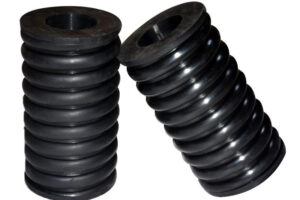Centrally-coiled cylindrical helical compression spring
What is cylindrical helical compression spring
A centrally-coiled cylindrical helical compression spring is a mechanical device designed to store and release energy. It consists of a tightly wound wire in the shape of a coil, with each turn touching the adjacent ones. This type of spring is commonly used in various applications, including automotive suspensions, industrial machinery, and even household appliances.
The primary purpose of a centrally-coiled cylindrical helical compression spring is to absorb and distribute force when it is compressed or pushed together. When an external force is applied to the ends of the spring, it compresses and stores potential energy. As the force is released, the spring expands, exerting the stored energy and returning to its original shape.
These springs are manufactured using high-quality materials such as steel or alloy, ensuring durability and strength. The wire used for their construction is carefully selected based on the specific requirements of the application. In addition, the coil pitch (distance between each turn) and diameter are crucial factors that determine the spring’s characteristics, including its load capacity and flexibility.
The design of the centrally-coiled cylindrical helical compression spring allows for efficient energy storage and release. Its compact structure enables it to withstand high compressive forces, making it ideal for applications where shock absorption, suspension, or resistance to pressure is required.
Despite being a simple mechanical component, these springs offer numerous advantages. They provide reliable and consistent performance, maintaining their properties over thousands of compression cycles. Moreover, they have a wide range of load capacities and can be custom-designed to suit specific operational requirements.
How to make Centrally-coiled compression spring
The centrally-coiled cylindrical helical compression spring is mostly manufactured through multi-piece winding, regardless of the control method used. The main requirements include achieving the required spring diameter, number of support coils, total coils, and pitch or free height as per the process specifications.
In manual control, the operator’s skill level has a significant impact on the geometric dimensions of the spring. During winding, it is important to avoid excessively high winding speeds. Firstly, the support coils should be tightened properly, and secondly, the working coils should be counted accurately, with the timely disconnection or closure of the adjusting nuts. When using an automatic opening-closing heading lathe for winding, careful selection of the opening-closing mechanism, heading tool, and wheel ratio for the number of coils is essential.
The calculation of the spring core shaft diameter and the total number of coils has been discussed in the previous sections. Calculating the winding pitch (the pitch before rebound) is more challenging because accurately estimating the change in free length of the spring before and after rebound is difficult. As an initial approximation for experimental purposes, this change can be neglected during estimation.
Subsequently, based on this approximate value (some may increase it by 5%~8%), the opening-closing wheel ratio is calculated. After trial winding, the original values are adjusted, and the accurate process pitch and opening-closing wheel ratio are determined.
For a compression spring with support coils on both ends and tightly closed ends, with each end ground to a thickness of 0.25d, the process pitch t’ during winding can be estimated using the corresponding formula.
In conclusion, the centrally-coiled cylindrical helical compression spring is a versatile and essential component used in various industries. Its ability to store and release energy efficiently makes it a reliable solution for applications where resilience, shock absorption, or suspension is necessary. The careful selection of materials and precise manufacturing techniques ensure the longevity and performance of these springs.







